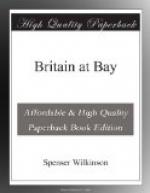THE TRANSITION
I have now explained the nature and working of a national army, and shown the kind of strength it will give and the probable maximum cost which it will involve when adopted.
The chief difficulty attendant upon its adoption lies in the period of transition from the old order to the new. If Great Britain is to keep her place and do her duty in the world the change must be made; but the question arises, how is the gulf between one and the other to be bridged? War comes like a thief in the night, and it must not catch this country unready.
The complete readiness which the new system, when in full swing, will produce, cannot be obtained immediately. All that can be done in the transition period is to see that the number and quality of men available for mobilisation shall be at least as high as it is under the existing system. It may be worth while to explain how this result can be secured.
Let us assume that the Act authorising the new system is passed during a year, which may be called ’00, and that it is to come into force on the 1st January of the year ’01. The Act would probably exempt from its operations the men at the date of its passing already serving in any of the existing forces, including the territorial army, and the discussion on the Bill would, no doubt, have the effect of filling the territorial army up to the limit of its establishment, 315,000 men.
On the 31st December ’00 the available troops would therefore be:—
Regulars in the United Kingdom (present
figure)
138,000
Special reserve 67,000
Army reserve (probably diminished from present
strength)
120,000
Territorial force 315,000 -------- Total 640,000 ========
From the 1st January ’01 recruiting on present conditions for all these forces would cease.
The regular army of
138,000
would lose drafts to India and the
Colonies
23,000
and would have lost during ’00
by waste at 5 per cent
6,900
-------
29,000
This would leave:
-------
regular army under old conditions
108,100
and leave room for recruits under
new conditions 91,900
=======
The total available for mobilisation during the year ’01 would therefore be:—
Regulars 200,000
Paid reserves (the present first-class reserve.
I assume an arbitrary figure below the
actual one)
120,000




